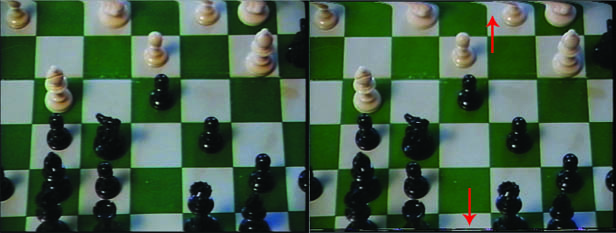An artifact which is generated by maladjustment or circuitry failure in an integrated or stand-alone time base corrector (TBC) can be categorized as a processing artifact. Depending on the type of TBC used, these have a diverse set of manifestations and can include over-enhancement and aggressive noise reduction. If a video signal output to a time base corrector is suddenly lost due to low RF from severe media damage, a head clog or some other incident, the TBC may output noise while the processor attempts to re-lock to the incoming video signal.
In the first example below, a TBC was introducing errors through overcorrection. The image on the left is the correct image processed through a properly functioning TBC, while the image on the right shows overcorrection for what would otherwise be minimal skewing at the top, and a line error now appearing along the bottom. During playback, this tape showed a vertically shaky display that wasn’t occurring before the signal was sent through the TBC.
The second example demonstrates an error introduced during one inch playback with a faulty TBC connection. The error presents as a horizontal wave pattern that moves up and down across the image, never leaving the top or bottom of frame but varying in height and depth. This error has been seen with faulty TBC connections for both one and two inch open reel formats, and in this instance continues for the full duration of the programme capture.
Can it be fixed?
This artifact may be correctable by readjustment or calibration of the TBC. If the TBC cannot process video output due to poor playback signal from the VTR, the media must be treated to improve playback or a different and more effective TBC must be used.
Example 1


